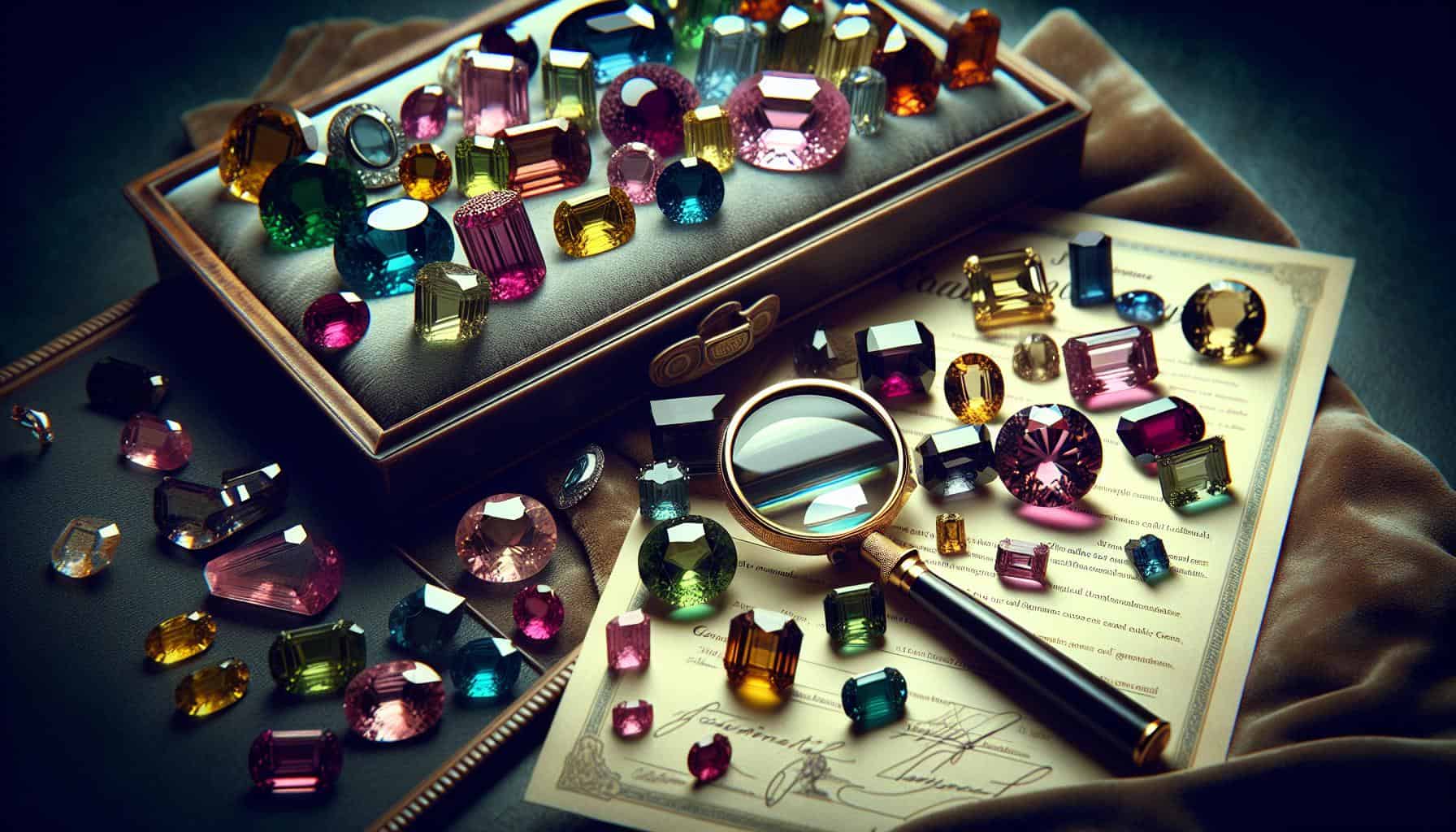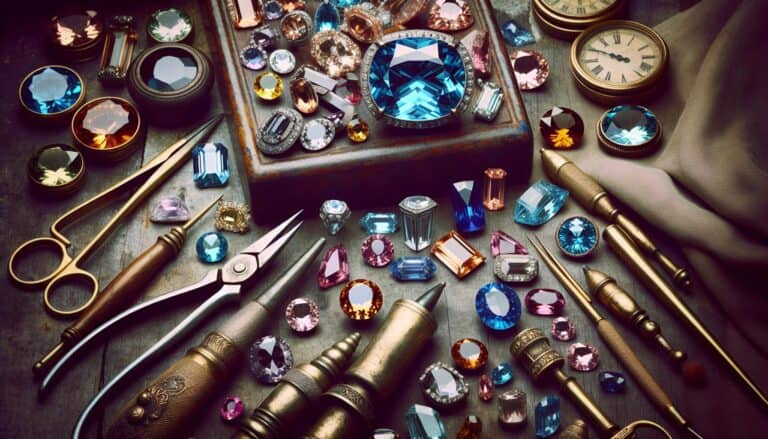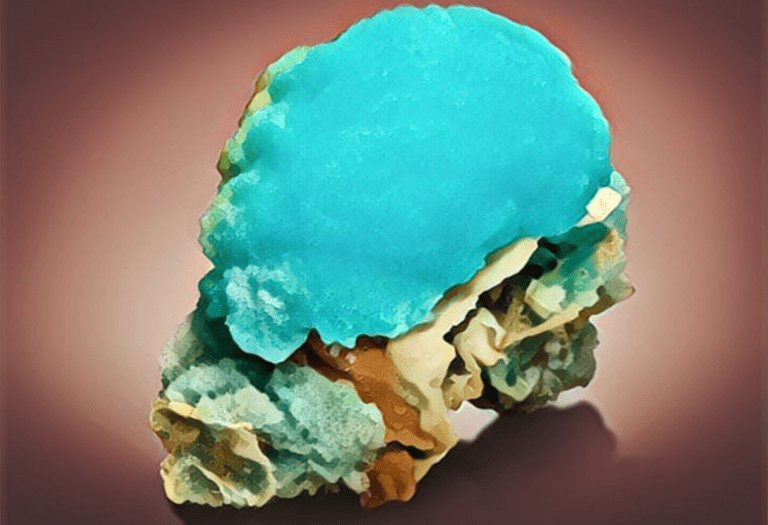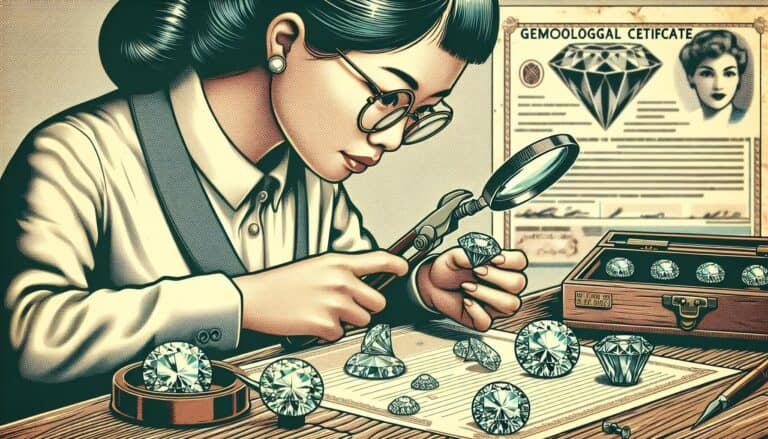Ever wondered about the value of those vibrant gemstones catching your eye in jewelry stores?
Tourmaline, with its rainbow of colors, might just be one of them. Understanding tourmaline’s worth isn’t just about price tags—it’s a fascinating dive into quality, rarity, and demand.
You’re right to be curious about how much tourmaline is worth. It’s not just another gemstone; it’s a complex beauty with a price range as varied as its hues. Whether you’re a collector, a jewelry enthusiast, or simply love a good gem hunt, getting to grips with tourmaline’s value is essential.
Factors like color saturation, clarity, and origin play a huge role in determining tourmaline’s market value.
But don’t worry, you’re about to get a clear-cut guide that’ll help you navigate the sparkling world of this beloved gem.
Tourmaline’s value is determined by color, clarity, cut, and rarity. Vibrant hues, especially neon blue Paraíba, command high prices. Market demand, rarity, and mining location also affect costs. Paraíba tourmalines can exceed $20,000 per carat, while prices for other types vary.
What Is Tourmaline?
Tourmaline is a semi-precious gemstone that has captivated many with its dazzling array of colors and unique physical properties. It’s not just a single mineral, but a group of minerals related in their physical and chemical characteristics. The beauty of tourmaline is that no two stones are exactly alike, making each piece you encounter distinct.
What sets tourmaline apart from other gemstones is its vast color spectrum. From deep greens and blues to vibrant pinks and reds, tourmaline’s variety is almost unparalleled in the gem world. This is due to trace elements such as iron, manganese, and chromium influencing the coloration of the stone. Perhaps the most sought-after are the watermelon tourmalines, which boast green exteriors and pink cores—akin to the fruit they’re named after.
But tourmaline is more than just a pretty stone; it’s also known for its remarkable electrical properties. When heated or put under pressure, these gems can become electrically charged—a characteristic that has fascinated scientists and gem collectors alike for centuries. This phenomenon is known as piezoelectricity.
In your quest to understand tourmaline’s worth, consider its durability. With a score of 7-7.5 on the Mohs scale, tourmalines are robust enough for use in various types of jewelry without worry of easy scratching or damage. This makes them an excellent choice for everyday wear pieces.
As you delve further into the world of tourmalines, you’ll discover that certain types, like the paraíba tourmaline, command higher prices due to their rarity and vibrant neon blue or green colors. You’ll find these versions are among the most prized in the current market.
Tourmaline Prices: Factors That Affect Value

In the world of gemstones, a multitude of factors come into play when determining the value of a particular stone. Tourmaline, with its vast color spectrum and unique properties, is no exception. The nuances of color, clarity, and cut quality, alongside market dynamics, all contribute to the worth of each tourmaline stone you might encounter. Understanding these factors will empower you with the knowledge necessary to assess tourmaline’s value.
Color, Clarity, and Cut Quality
When it comes to tourmaline, color reigns supreme as the most influential value determinant. Here’s a breakdown for your easy reference:
- Red and pink tourmalines, affectionately called rubellites, are prized for their deep hues.
- Green tourmalines exhibit a rich, verdant color that’s coveted by many.
- Blue tourmalines, especially the rare paraíba variant, can fetch premium prices due to their scarcity.
Color saturation and tone are pivotal; the more vivid and pure the color, the higher the value. Keep in mind that well-saturated stones with no brown or gray overtones are especially sought after.
Moving to clarity, tourmalines are typically type II or III gemstones, meaning they often contain natural inclusions. While high clarity is a bonus, a few inclusions are generally acceptable, especially if they aren’t visible to the naked eye.
Lastly, the cut quality can’t be overstated. A skilled cutter can enhance the gemstone’s natural beauty, ensure maximum brilliance, and even minimize the appearance of inclusions. An exemplary cut can also counteract dark spots known as “bowties” in certain tourmalines, thereby elevating the stone’s overall appeal and worth.
Market Demand and Availability
Tourmaline’s value is also heavily swayed by market demand and the gemstone’s availability—fundaments that help dictate price fluctuations. Here are the key points:
- Rarity: Unique tourmaline colors, like the electric blues and greens of paraíba tourmaline, carry a heftier price tag due to their rare nature.
- Location: Certain origins are more esteemed than others. For instance, tourmalines from Brazil or Namibia might be valued more highly, affecting their market price.
- Fashion trends: Current style trends can lead to a surge in certain colors or types of tourmaline.
- Supply chain: The journey from mine to market impacts the final cost. Fewer intermediaries typically mean a lower price for the end consumer.
Keep track of gemstone market trends and reports to understand how these factors can influence tourmaline’s value at any given time.
Understanding Tourmaline: A Rare Gem

When you’re scoping out the value of tourmaline, knowing what makes it rare adds layers to your comprehension of its worth. Rarity is not just about how seldom a gemstone is found, but also about its uniqueness, its color range, and the mining difficulties it presents.
The Rarity of Tourmaline
Tourmaline’s vast spectrum of colors contributes to its rarity. Unlike diamonds, where a colorless stone might be the most sought after, tourmaline’s value often skyrockets with the presence of unique or intense colors. You’ll find that certain hues, like the neon blues of Paraiba tourmaline, are much rarer and thereby more expensive due to their limited geographic origins.
In addition to color, tourmaline possesses other rare characteristics. For instance, some stones exhibit pleochroism, showing different colors when viewed at different angles. Tourmalines may also be dichroic, meaning they demonstrate two colors simultaneously. These unique properties aren’t just fascinating—they raise the gemstone’s rarity, and ultimately, its value.
Not all tourmalines are created equal, though. The variances in trace elements such as iron, manganese, and lithium affect their scarcity. For example, stones rich in lithium, typically found in regions like Afghanistan and Brazil, are rarer, further fueling the gemstone’s mystique.
Origins and Characteristics
Tourmaline is an intriguing gemstone not just for its rarity, but also for its origins. It’s mined across the world, but significant deposits come from countries like Brazil, Madagascar, and Africa. Each location offers tourmalines with distinct qualities and stories. For example, Brazilian tourmalines are renowned for their wide color range, thanks to the country’s diverse geological conditions.
When evaluating tourmaline’s characteristics, consider:
- Color zones within a single crystal
- Potential for custom cuts to enhance natural beauty
- Variations that demand a premium in different markets
You may be surprised to learn that the stone’s geographical origin can affect its characteristics and, by extension, its value. Stones that hail from renowned mines or locales that produce exceptional quality or colors are typically more prized.
Tourmaline’s unique crystal structure also plays a role in its worth. With a complex silicate structure containing boron, tourmaline is unlike any other gemstone. This intricate structure not only leads to the stone’s wide color range but also contributes to its durability. It might interest you to know that despite its hardness, tourmaline can be prone to chipping and cracking if not handled with care during cutting and setting.
As you delve further into the world of tourmaline, you’ll quickly see that its worth is as multifaceted as the gemstone itself. Keep these insights in mind as you explore the various factors that establish the value of this captivating gem.
Tourmaline Grading and Valuation
When you’re delving into the world of precious stones, understanding how tourmaline’s value is assessed is crucial. Grading systems and professional appraisals play vital roles. Just like diamonds have the 4Cs, tourmaline has its own set of criteria that influences its worth.
The Grading System for Tourmaline
Tourmaline’s grading is a nuanced process, taking into account several key attributes:
- Color: Look for vibrancy and saturation. The more intense and unambiguous the color, the higher the grade.
- Clarity: High clarity enhances value, as fewer inclusions mean a more pristine gem.
- Cut: A skilled cut that maximizes brilliance and minimizes flaws is desirable.
- Carat Weight: Larger stones are less common and can command higher prices per carat.
Graders also assess the overall quality by examining the stone’s finish and symmetry. While there isn’t a standardized global grading system like GIA for diamonds, these factors are universally acknowledged in determining tourmaline’s quality.
Certification and Appraisal
To ensure you’re getting your money’s worth, seek out certified tourmaline. Certification from reputable gemological institutions can authenticate the gemstone’s natural origins and confirm its quality attributes. A certified evaluation typically includes:
- Detailed measurements
- Weight
- Color quality
- Clarity
- Cut details
Professional appraisals are another step to assess value, particularly if you’re considering an investment or insurance. An appraiser examines both the gemstone and its market value, taking current trends and market demand into account.
Remember, reputable appraisals should be conducted by certified professionals and, ideally, take place in a well-equipped gemological laboratory. While certificates and appraisals add to the overall cost, they’re essential for ensuring that you understand the full value of your tourmaline and make an informed purchase. Keep these insights in mind to navigate the complexities of tourmaline valuation with confidence.
Current Market Trends in Tourmaline Pricing
When you’re exploring tourmaline gems, understanding current market trends is crucial. Prices for tourmaline fluctuate due to a variety of factors, including fashion trends, technological advancements, and shifts in supply and demand.
Fashion trends have a significant impact on tourmaline prices. For instance, when a particular color becomes popular, the value of tourmalines in that hue can spike. In recent years, pastel-colored tourmalines have seen a surge in demand, elevating their value within the market. If you’re eyeing a specific color, keep a pulse on the fashion industry’s influence on consumer preferences.
Another trend to watch is the impact of technological advancements in gemstone treatments. Techniques such as heat treatment can enhance the color and clarity of tourmaline, thus affecting their desirability and price. Keep an eye out for untreated stones, as these may command a premium for their natural qualities.
Regarding supply, the discovery of new mines or the depletion of existing ones can alter the rarity—and ultimately the price—of certain tourmaline varieties. For example, Paraíba tourmalines, known for their vivid blue color, are extremely rare. A change in their availability can cause market prices to swing dramatically. Be alert to news about significant changes in tourmaline mining activities.
Lastly, the economic climate plays a significant role in tourmaline pricing. Global economies influence luxury goods spending, where tourmalines often come under. During periods of economic stability, there may be an increased willingness among consumers to invest in higher-priced gems, driving up the demand and price for quality tourmalines.
It’s vital to research and understand the nuances of the current market landscape. This information isn’t just interesting—it’s essential for making an informed decision on when and what type of tourmaline to purchase. Stay updated on the latest gemstone reports and market analyses to gauge an accurate picture of tourmaline pricing trends.
The Most Expensive Tourmaline
When you’re looking into the cream of the crop in tourmaline gems, you’ll find that Paraiba tourmalines command the highest prices. These mesmerizing stones, known for their vivid blue and green hues, are sourced from the Paraiba state in Brazil and the African continent. The intense neon colors of these stones, coupled with their rarity, can drive prices up to thousands of dollars per carat. In fact, the price for high-quality Paraiba tourmaline can exceed $20,000 per carat for larger sizes.
Another factor that contributes to the hefty price tag is copper content. Paraiba tourmalines obtain their spectacular glow from copper inclusions, which are less common than other types of mineral inclusions. The presence of copper not only creates a unique brilliance but also certifies the authenticity of these prized gems.
Aside from Paraiba tourmaline, certain pink and red tourmalines—referred to as rubellites—are also highly valuable. These stones exhibit a depth of color that is comparable to fine rubies, without the same price tag, making them an attractive option for those seeking a stunning, yet more affordable, alternative.
Market demand influences prices as well, and Tourmaline’s popularity in fine jewelry has soared due to its wide color range and uniqueness. The shift in consumer preferences towards more unique and expressive gemstones has created an upsurge in value for exceptional pieces of tourmaline.
To give you a sense of the market, here’s a quick rundown of tourmaline prices based on color and quality:
| Color | Average Price Per Carat | Note |
|---|---|---|
| Paraiba | $5,000 – $20,000+ | Subject to quality |
| Rubellite | $300 – $1,000 | Depending on size |
| Chrome | $200 – $500 | Chrome-rich green hues |
| Bi-color | $500 – $3,000 | Unique color combinations |
The value of your tourmaline isn’t just in its price, but also in its aesthetic appeal and the joy it brings to you as a collector or enthusiast. Keep in mind that each stone carries its own story and unique characteristics that add to its allure and worth.
Buying Tourmaline: Tips and Recommendations
Where to Purchase High-Quality Tourmaline
When you’re on the hunt for high-quality tourmaline, your options might seem endless. Jewelers, online stores, and gem shows are typical outlets, but each has its benefits and pitfalls. Local jewelers provide the advantage of seeing the stone’s true color and quality firsthand with the aid of a professional. However, their selections may be limited, and prices can be higher due to overhead costs.
On the flip side, online stores offer a broader range of choices and often better prices. But be wary, as images can be deceptive. Always ensure the seller provides certification and a clear return policy. Lastly, gem shows are ideal for seeing a variety of tourmaline in one place. They allow you to compare prices and quality while building relationships with expert dealers. Always do your research before attending a gem show to know what you’re looking for and understand the market value.
Ensuring Authenticity and Value
Tourmaline’s value can be significantly affected by its authenticity and quality. To ensure you’re getting what you pay for, always request a certificate of authenticity from a reputable gemological laboratory. This certificate should include details about the stone’s origin, color, clarity, and any treatments it has undergone.
When considering the value, remember that tourmaline prices can vary greatly based on size, color, and clarity. A transparent pricing scale, based on carat weight and quality, should be provided by the seller. Be vigilant for signs of enhancement, such as unnatural colors or overly clear gems that might indicate the stone has been treated.
Purchasing tourmaline could be a significant investment, so you should never rush into a decision. Take the time to educate yourself, compare options, and make purchases from reputable dealers who are transparent about their products and willing to answer all your questions. By following these recommendations, you’ll be better positioned to acquire a tourmaline gemstone that not only meets your expectations in quality and beauty but also holds its value over time.
Conclusion: Buying & Selling Tourmaline
Understanding the true worth of tourmaline means looking beyond price tags. It’s about appreciating the stone’s unique beauty and the factors that contribute to its value.
You’ve got the insights on what to look for and where to find the best pieces. Armed with knowledge and a keen eye, you’re ready to select a gemstone that’s not just an adornment but an investment. Remember, the right tourmaline can offer you a lifetime of enjoyment and even become a cherished heirloom.
So go ahead, make an informed choice and treasure your tourmaline for its true worth.



![Tennessee Rockhounding Sites in [year]: Gems & Fossils](https://observationhobbies.com/wp-content/uploads/2024/01/EFGCim-a-H4l1G9wAyX6B-768x439.jpg)

![Kansas Rockhounding Sites in [year]: Best Spots & Treasures](https://observationhobbies.com/wp-content/uploads/2024/01/MEpyAlU09VN0IV9zhK62K-768x439.jpg)

